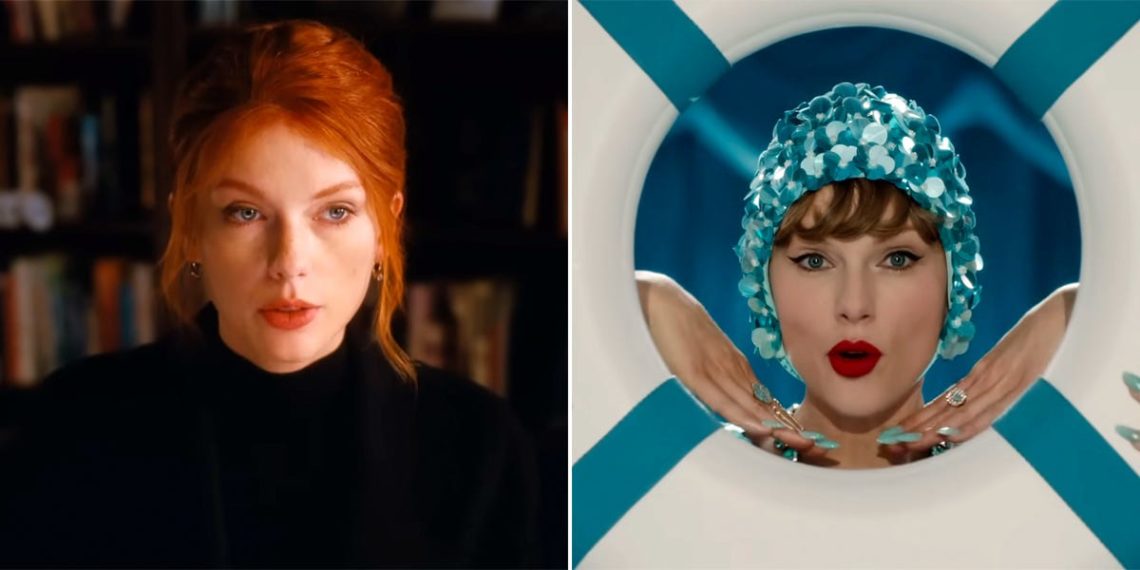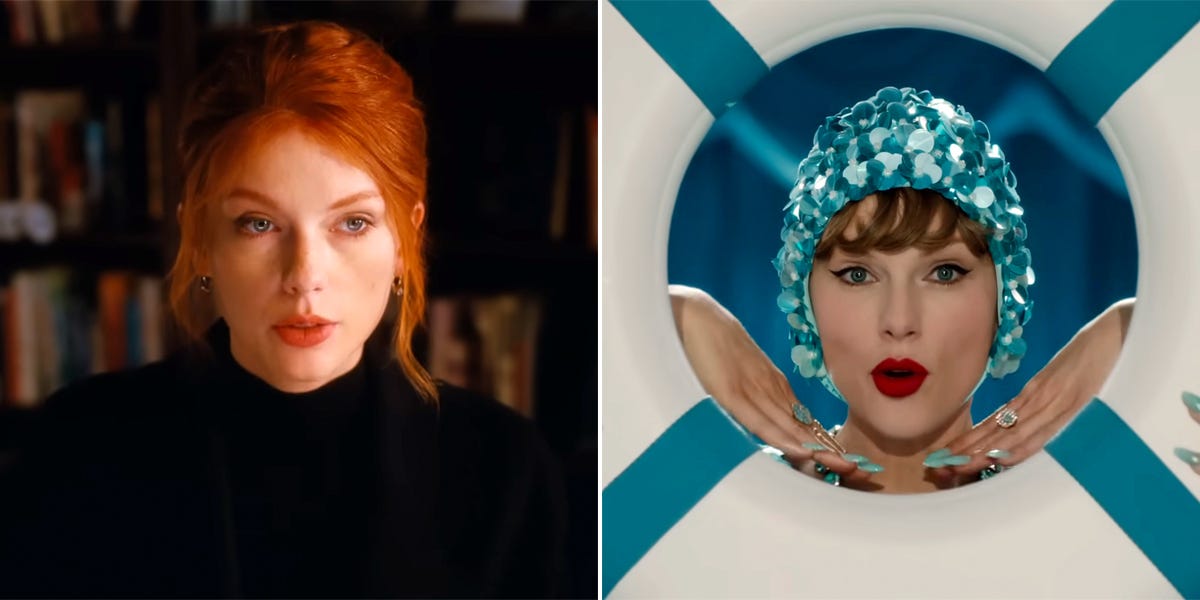
Taylor Swift/YouTube
- Taylor Swift is known for her storytelling and poetic lyricism.
- Her lyrics reference novels by Daphne du Maurier, F. Scott Fitzgerald, Kurt Vonnegut, and more.
- Swift’s newest single, “The Fate of Ophelia,” subverts the fate of Shakespeare’s famous heroine.
Taylor Swift may be a pop star and business mastermind, but she’s most beloved by fans for being a storyteller.
“Everybody has their own sort of niche or specialty thing that they do that, you know, sets them apart from everybody else,” Swift said in “Miss Americana,” her 2020 Netflix documentary. “And my storytelling is what is for me. I know that without me writing my own songs, I wouldn’t be here.”
Swift recently unveiled her newest album, “The Life of a Showgirl.” The first track and lead single, “The Fate of Ophelia,” is named after the heroine from William Shakespeare’s “Hamlet.”
Of course, Ophelia isn’t the first literary figure Swift has referenced — or even the first tragic Shakespearean death she’s subverted.
Swift has woven her music with nods and allusions to poets, playwrights, novelists, and even biographers throughout her career. Below, Business Insider’s senior pop culture writer analyzes 25 of Swift’s songs from a literary perspective.
“The Outside” contains a clear reference to Robert Frost.

John Shearer/WireImage
“The Outside” is one of the oldest songs in Swift’s catalog. She wrote the track for her debut album when she was just 12 years old, inspired by her experience of being “a complete outcast at school.”
“I tried to take the road less traveled by / But nothing seems to work the first few times,” she sings in the pre-chorus.
Anyone with a cursory poetry education will recognize the reference to Robert Frost’s “The Road Not Taken,” thanks to its popularity in elementary-school curricula.
The poem’s conclusion is often read as a celebration of originality and self-determination, teasing the reward that may come with great risk: “Two roads diverged in a wood, and I— / I took the one less traveled by, / And that has made all the difference.”
In the life of a 12-year-old girl, “the road less traveled by” could easily represent the path of an outcast, someone excluded from ordinary experiences and the joy of community.
Bonus: This reference to Frost reappears in both “Illicit Affairs” (“Take the road less traveled by / Tell yourself you can always stop”) and “‘Tis the Damn Season” (“The road not taken looks real good now”). In the latter, Swift’s character takes the road more frequently traveled and later comes to regret it.
“Love Story” is an optimistic retelling of “Romeo + Juliet.”
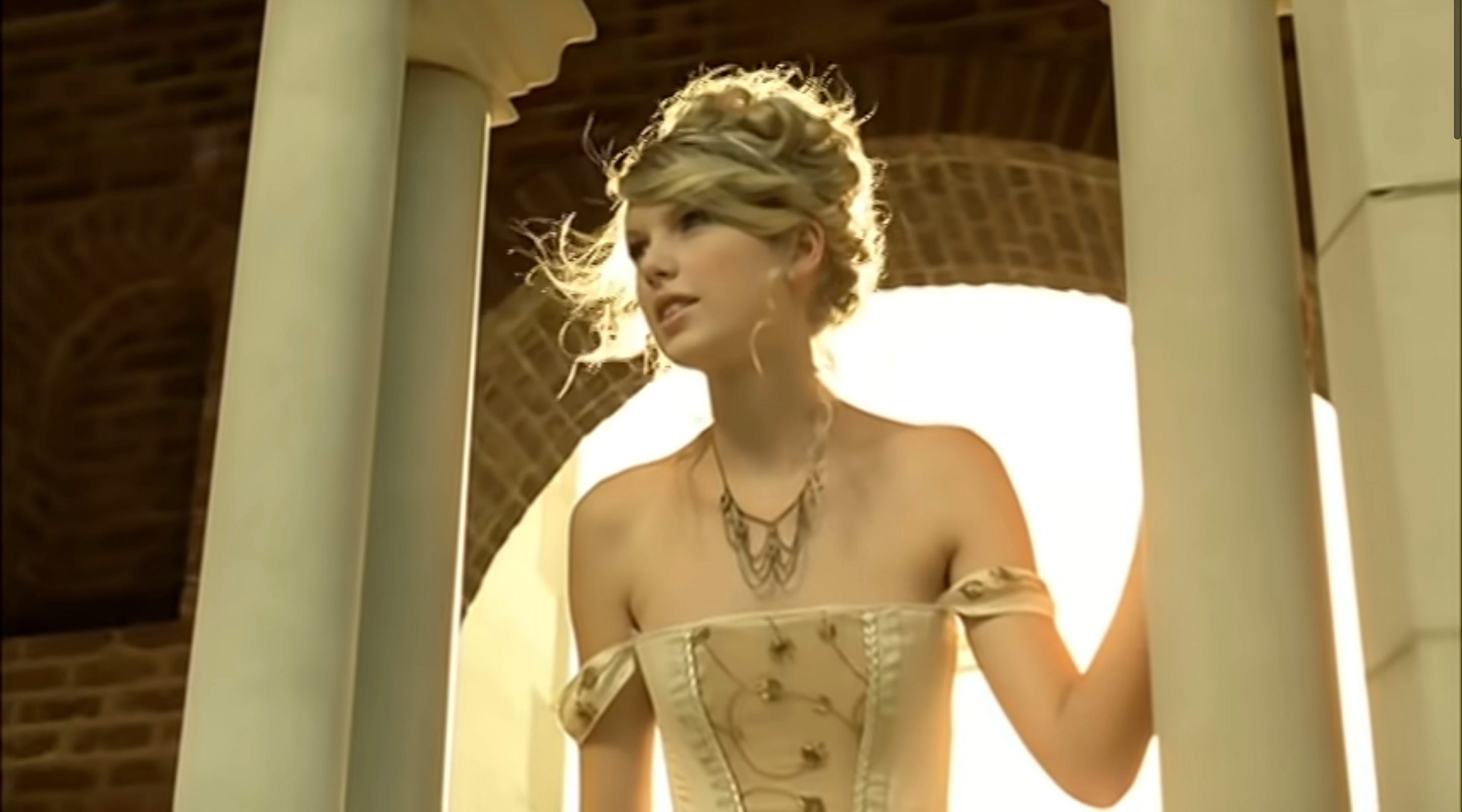
Taylor Swift/YouTube
Swift’s best-known literary reference is “Love Story.” As a teenage songwriter, she inserted herself into Shakespeare’s tragic romance to evoke scenes of youth, rebellion, yearning, and destiny, then added a plot twist.
In Swift’s version, Romeo wins the approval of Juliet’s father, and the young lovers enjoy a happy ending.
“All Too Well” is thematically connected to Pablo Neruda’s “Tonight I Can Write.”

Aldara Zarraoa/Getty Images for TAS Rights Management
In the liner notes for “Red,” Swift included a quote from the Chilean poet Pablo Neruda: “Love is so short, forgetting is so long.”
The line is translated from “Puedo Escribir Los Versos,” or “Tonight I Can Write.”
Neruda was just 19 years old when “Tonight I Can Write” was published in 1924. It was included in a collection titled “Veinte poemas de amor y una canción desesperada,” or “Twenty Love Poems and a Song of Despair,” which is now known as his most celebrated work.
Similarly, Swift wrote “Red” when she was between the ages of 20 and 22. The album is a collection of passionate ballads and breakup anthems, spanning the full emotional range that comes with an intense, ill-fated love affair.
The Neruda quote also opens the “All Too Well” short film, which shows Swift’s proxy character falling madly in love, then spending years grappling with the aftermath.
Both “Tonight I Can Write” and “All Too Well” speak to the weaponization of memory, illustrating how sweet experiences with a loved one can become sharp and painful in retrospect — that even “the endless sky” (Neruda) or “the first fall of snow” (Swift) can feel sinister in their absence.
“Wonderland” is a “twisted” take on Lewis Caroll’s “Alice’s Adventures in Wonderland.”
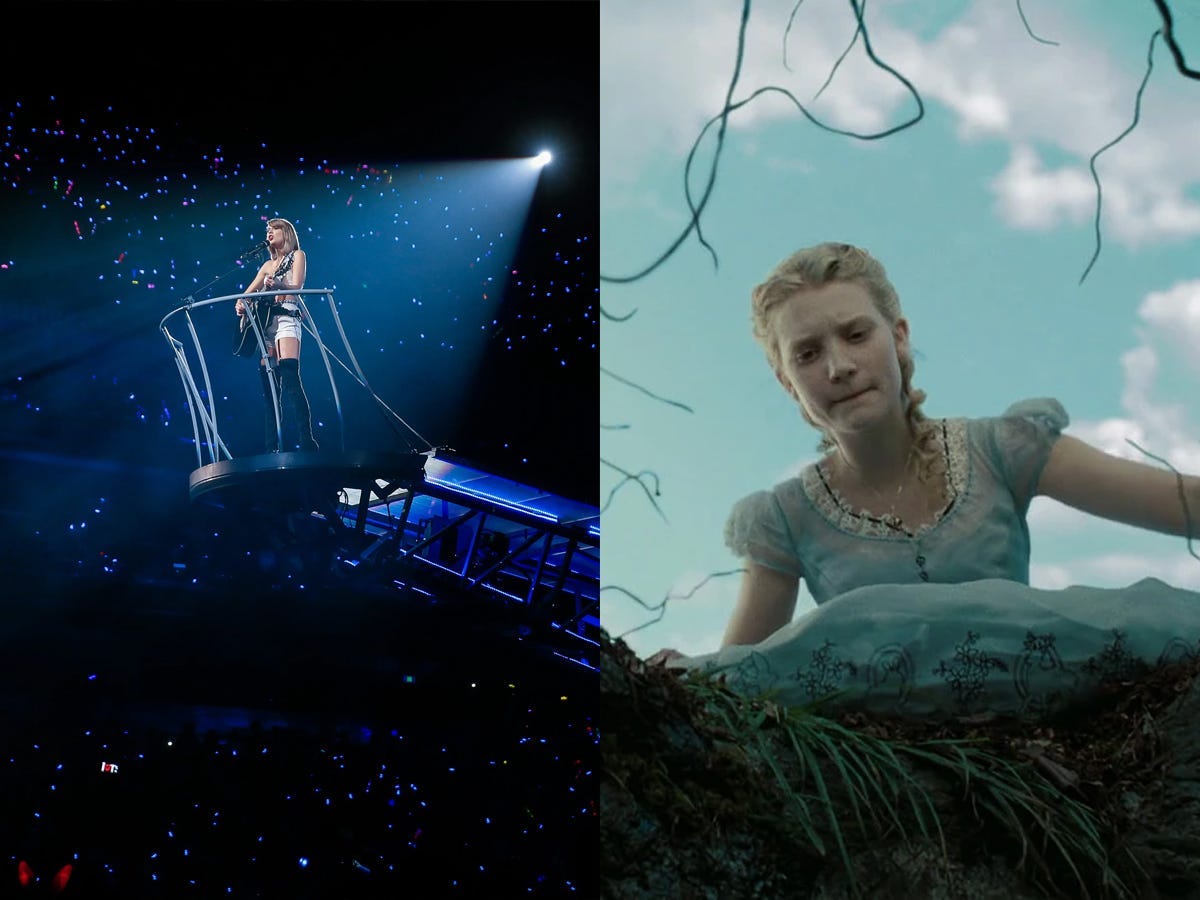
Liu Xingzhe/Visual China Group via Getty Images; Walt Disney Studios
As Swift told a crowd at the Eras Tour, her 2014 breakup song “Wonderland” was inspired by Lewis Carroll’s 1865 novel. Swift uses “falling down the rabbit hole,” which transports Alice to Wonderland, as an extended metaphor for falling in love — and losing her mind in the process.
“Haven’t you heard what becomes of curious minds?” Swift sings in the pre-chorus, a reference to Alice’s observation that “curiosity often leads to trouble.”
Swift aligns herself with the book’s band of outsiders with lyrics like “too in love to think straight” and “we both went mad.” She also compares her ex-lover to the deceitful Cheshire Cat character (“Didn’t you calm my fears with a Cheshire Cat smile?”).
Bonus: Swift revisited the concept of “falling down the rabbit hole” in her 2020 song “Long Story Short,” doubling down on its negative implications (“And I fell from the pedestal / Right down the rabbit hole / Long story short, it was a bad time”).
“New Romantics” kicks off with an explicit reference to “The Scarlet Letter.”

Dimitrios Kambouris/Getty Images for TAS; Sony
In broad terms, “New Romantics” is a song about rising above the noise and standing by your choices, even if others malign them.
“There is a lesson in knowing that you can live your life in a way that you’re proud of and people are still gonna take shots,” she told Vanity Fair one year before the song’s release.
In the first verse, Swift sings, “We show off our different scarlet letters / Trust me, mine is better.”
Nathaniel Hawthorne’s classic novel “The Scarlet Letter” is set in the Puritan Massachusetts Bay Colony in the 1600s. It tells the story of Hester Prynne, who gives birth out of wedlock. She is shunned by her community and forced to wear a red “A” (for “adultery”) to broadcast her shame. Her male lover, however, shares no blame for most of the book.
From a modern perspective, the community’s reaction is overblown and indefensible.
Swift’s cheeky brag about her scarlet letter reflects this understanding; she draws a parallel between her own treatment by society and the misogynistic, puritanical mob mentality that Hester is subjected to.
By this time in Swift’s career, her dating life had become a source of gossip, speculation, and oft-unsavory media coverage. Many tabloids branded her a “player” or even a “maneater,” while in other corners of the internet, rumors about her relationship with Karlie Kloss had recently begun to pick up steam.
Swift’s flippant response in “New Romantics” recalls “Blank Space,” the second single from “1989,” in which she pokes fun at her own headlines and satirically embraces her reputation (“Got a long list of ex-lovers / They’ll tell you I’m insane”).
She doubles down in the second verse of “New Romantics” (“The rumors are terrible and cruel / But honey, most of them are true”).
Throughout the song, Swift expresses a distrust of society and enduring faith in her own ideals, echoing the main theme of “The Scarlet Letter,” which ends with Hester’s redemption and the death of her lead tormentor.
Bonus: Swift originally aligned herself with Hester in her 2008 single “Love Story” (“You were Romeo, I was a scarlet letter”), another song about fighting social convention in order to live and love authentically.
“…Ready For It?” name-drops Elizabeth Taylor and Richard Burton, whose relationship was immortalized in “Furious Love.”

Don Arnold/TAS18/API/GAMMA/Gamma-Rapho via Getty Images
In the opening track of “Reputation,” Swift sings, “He can be my jailer, Burton to this Taylor / Every love I’ve known in comparison is a failure.”
Richard Burton and Elizabeth Taylor’s love story was chronicled in “Furious Love: Elizabeth Taylor, Richard Burton, and the Marriage of the Century” by Sam Kashner and Nancy Schoenberger.
Swift confirmed she read the joint biography in a 2018 interview. The book can also be spotted in Swift’s Instagram highlight, “ladies & benji.”
Interestingly, the tone of “Furious Love” doesn’t seem to complement Swift’s lyrics, since Burton and Taylor’s relationship would be considered a failure by most standards. They shared a torrid and obsessive connection, characterized by “delightful screaming matches,” in Taylor’s own words.
“I don’t want to be that much in love ever again.… I gave everything away…my soul, my being, everything,” Taylor told a friend after their second divorce, according to “Furious Love.”
By including this reference, Swift may have been signaling a deeper, more sinister level to the “…Ready For It?” romance, lurking beneath her initial attraction.
Throughout their tumultuous relationship, Burton and Taylor made 11 movies together, including classics like “Who’s Afraid of Virginia Woolf?” (1966) and “Antony and Cleopatra” (1972).
They also costarred in “The Taming of the Shrew,” based on Shakespeare’s play of the same name, which could be another point of reference for Swift’s lyrics (“I’m so very tame now / Never be the same now”).
Burton plays Petruchio and Taylor plays Katherina, aka Kate, the titular “shrew.”
In both the original and the film adaptation, Taylor’s character is headstrong and independent — until Burton’s character “tames” her with psychological and physical torture, forcing her into the role of an obedient bride.
Bonus: Swift doubles down on her connection to Taylor in “The Life of a Showgirl,” which features a track named after the starlet. Swift described the song as “half-cosplay” and half-personal perspective.
“It’s got to do with fame, attention, love, notoriety, anxiety that this isn’t gonna be forever — and how heartbroken would you be then?” Swift said of “Elizabeth Taylor” in the album’s release party film. “I used details from her life, but the feelings of what it conveys are things that I’ve absolutely experienced.”
“Don’t Blame Me” may contain a subtle nod to Daisy Buchanan.

Warner Bros; John Shearer/TAS23/Getty Images for TAS Rights Management
In the second verse of “Don’t Blame Me,” Swift sings, “I once was poison ivy, but now I’m your daisy.”
Sure, this could be intended as a simple comparison between a dangerous plant and an innocent flower. But Swift is a noted fan of “The Great Gatsby,” F. Scott Fitzgerald’s seminal novel; she name-drops the titular character later on this very same album.
Thus, the lyric in “Don’t Blame Me” could be another name-drop.
Gatsby’s love interest, Daisy Buchanan, is described by the book’s narrator as “the golden girl.” Gatsby also describes Daisy’s voice as “full of money.” She is heavily associated with the colors gold and yellow throughout the book.
Swift also uses gold to represent love and beauty throughout the latter half of her discography, in songs like “End Game” (“It’s like your eyes are liquor, it’s like your body is gold”), “Dancing With Our Hands Tied” (“Deep blue but you painted me golden”), “Dress” (“Made your mark on me, a golden tattoo”), “Daylight” (“I once believed love would be burning red, but it’s golden”), “Invisible String” (“One single thread of gold tied me to you”), and “Gold Rush” (“Everybody wants you / But I don’t like a gold rush”).
“Delicate” contains another subtle Fitzgerald parallel.
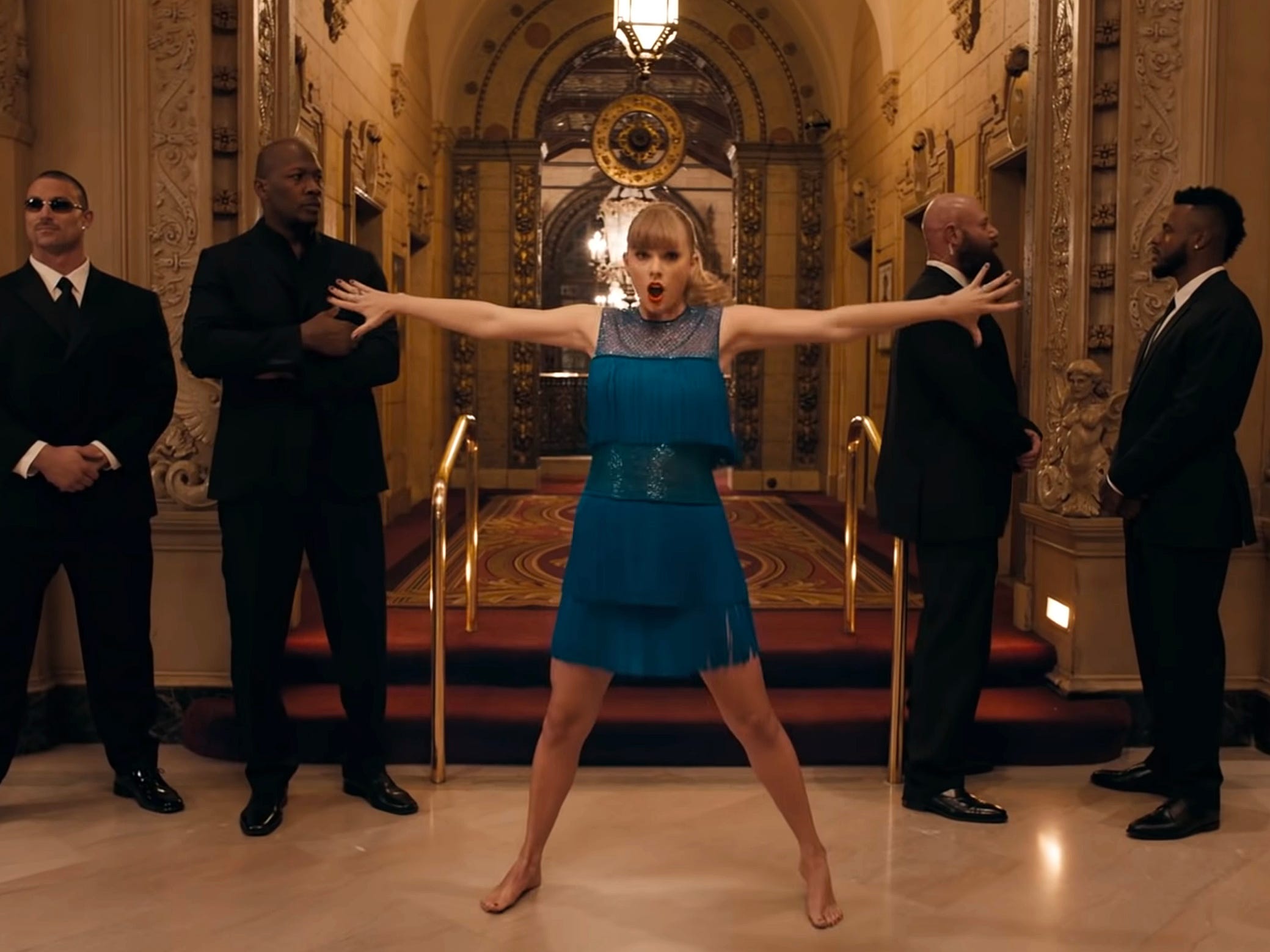
Taylor Swift/YouTube
The fragility of love is a common theme in Swift’s music, especially when it contrasts with the harshness of reality (as in “Treacherous,” “Out of the Woods,” “I Know Places,” and “The Archer,” among others).
“Delicate” is a particularly notable example. Swift sings about falling in love with someone new, all while wrestling with the knowledge that either of their hearts could break.
The song echoes a memorable passage from Fitzgerald’s “This Side of Paradise,” which Swift read (and liked) in 2013, long before starting work on “Reputation.”
The novel follows a promising young college student named Amory Blaine and his three failed attempts to make a relationship last.
In the book’s first section, titled “The Romantic Egotist,” Amory overhears his mother talking about him: “‘This son of mine,’ he heard her tell a room full of awestruck, admiring women one day, ‘is entirely sophisticated and quite charming — but delicate — we’re all delicate; here, you know.”
“So It Goes…” shares a striking similarity with “Slaughterhouse-Five.”
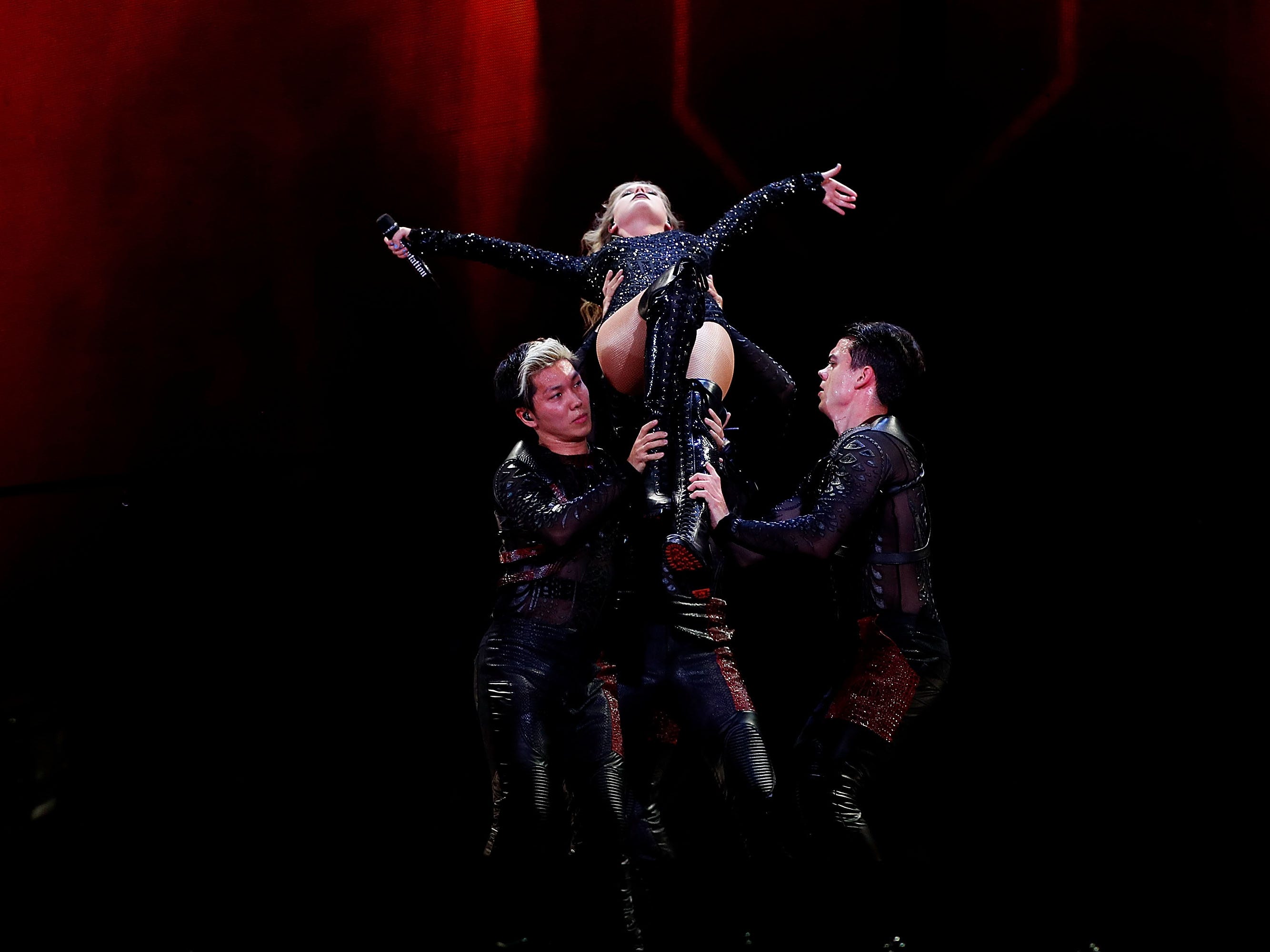
Don Arnold/TAS18/Getty Images
“So It Goes…” shares its name with the most famous phrase from Kurt Vonnegut’s celebrated novel “Slaughterhouse-Five.”
The book’s protagonist, Billy Pilgrim, is a World War II veteran whose trauma breaks his ability to form a cohesive narrative. He constantly finds himself back in Germany, presumably due to PTSD-induced flashbacks; he refers to this as becoming “unstuck in time.”
Vonnegut explores this theme through the Tralfamadorians, a race of aliens who do not see time as linear, but rather “as you might see a stretch of the Rocky Mountains.”
To them, all moments in the past, present, and future are happening simultaneously.
After his abduction, Billy adopts the Tralfamadorian idiom “so it goes,” which is used 106 times in the book — usually when someone has died.
The phrase evokes a feeling of inevitability and powerlessness, but it’s not purely nihilistic. The Tralfamadorians don’t recognize death as tragic and final because, in their understanding of time, that person is still alive in many other moments.
Throughout “Slaughterhouse-Five,” Billy is characterized as very lonely. His family and friends don’t understand the intensity of what he’s been through, so his coping mechanisms are widely misunderstood.
Swift has also described the “Reputation” era as “a very isolating experience,” following an online cancellation campaign that spun wildly out of her control.
“I don’t think there are that many people who can actually understand what it’s like to have millions of people hate you very loudly,” she told Vogue.
Perhaps Swift, like Billy, found comfort in the Tralfamadorian way, a kind of radical acceptance in the face of upheaval. The phrase “so it goes” asserts that death isn’t the endpoint of a person’s existence.
Notably, “So It Goes…” is placed on the tracklist immediately after “Look What You Made Me Do,” a song that satirizes Swift’s own demise (“The old Taylor can’t come to the phone right now. Why? Oh, ’cause she’s dead!”).
“Getaway Car” opens with an allusion to “A Tale of Two Cities.”

Don Arnold/TAS18/Getty Images
“A Tale of Two Cities” by Charles Dickens contains one of the most famous opening phrases in all of literature: “It was the best of times, it was the worst of times.”
In the first line of “Getaway Car,” Swift swaps the last word for “crimes.”
Swift uses the getaway-car metaphor to tell the story of a doomed relationship, which she used selfishly as a vehicle for escape.
The song gestures at infidelity, painting Swift as a liar and a thief (“Put the money in a bag and I stole the keys / That was the last time you ever saw me”).
However, it also plays with the idea of morality, painting Swift’s actions as justified in the face of a much bleaker fate (“I wanted to leave him, I needed a reason”).
This ambiguity speaks to the full version of Dickens’ opening line, in which he presents a list of opposites and dueling ideas: “It was the best of times, it was the worst of times, it was the age of wisdom, it was the age of foolishness, it was the epoch of belief, it was the epoch of incredulity, it was the season of Light, it was the season of Darkness, it was the spring of hope, it was the winter of despair, we had everything before us, we had nothing before us, we were all going direct to Heaven, we were all going direct the other way.”
Like Swift, Dickens suggests that everything exists as a push-pull; nothing is simply good or bad, black or white.
“This Is Why We Can’t Have Nice Things” explicitly references “The Great Gatsby.”

Warner Bros. Pictures/Roadshow Entertainment
“This Is Why We Can’t Have Nice Things” opens with a scene of opulence and hedonism: big parties, champagne seas, rattling chandeliers, no rules.
Swift sums up the scene with an explicit Fitzgerald reference: “Feeling so Gatsby for that whole year.”
“The Great Gatsby” is set in New York City in the 1920s, commonly known as the Jazz Age. It was a time characterized by excess — of wealth, of alcohol, of self-indulgence — that partially led to the stock-market crash of 1929.
In the book, Gatsby is a key player in the city’s party scene, known for hosting blowouts at his mansion and allowing guests to act however they please.
However, he’s also a man of deception. It’s heavily implied that he made his fortune illegally, most likely by smuggling alcohol during prohibition. He doesn’t drink; his extravagant parties are actually a scheme to seduce Daisy. His real name isn’t even Gatsby.
So the Gatsby reference pairs nicely with the theme of Swift’s song: deception. Swift goes on to describe how she was stabbed in the back, lulled into a false sense of security by the glittering artifice of celebrity and friendship.
“Cardigan” and “Peter” both mention Peter Pan.
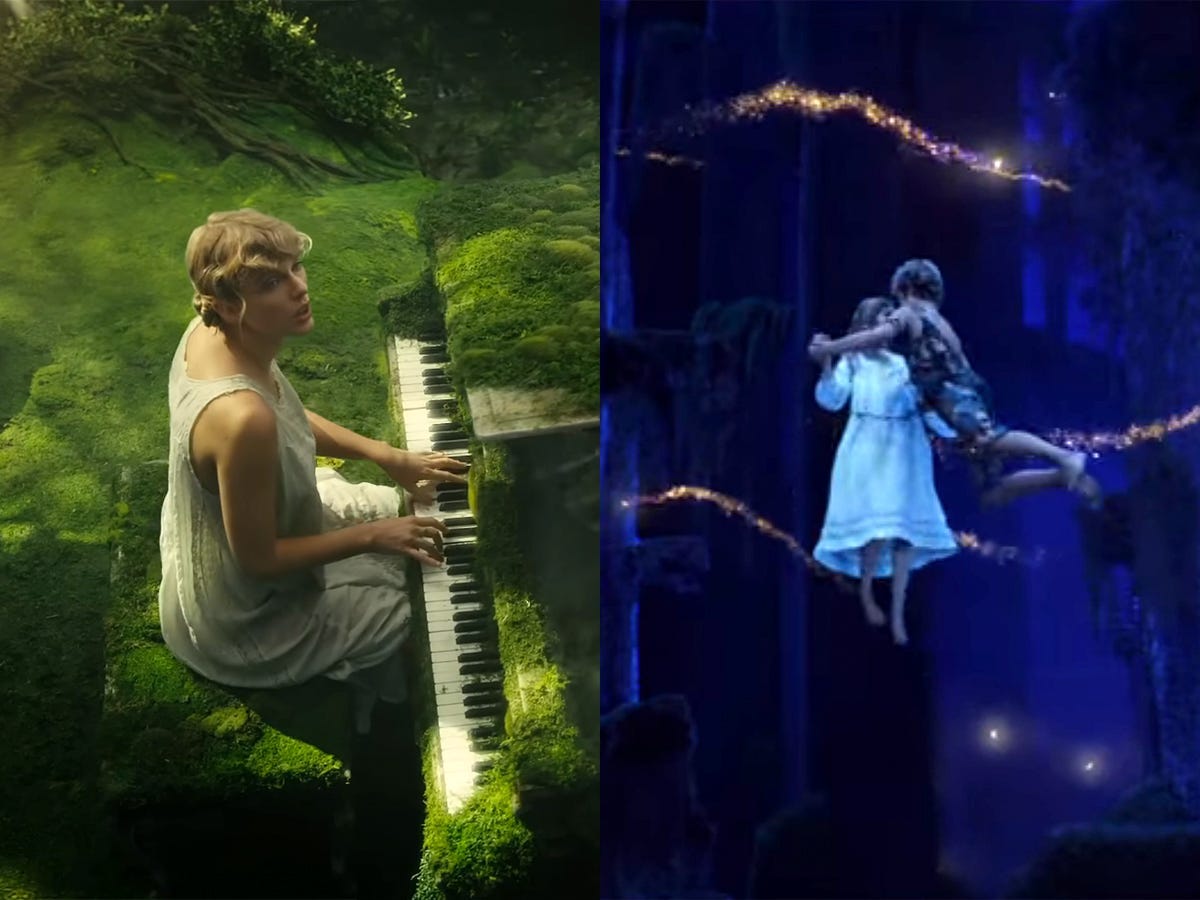
Taylor Swift/YouTube; Universal Pictures
Peter Pan, a character created by novelist and playwright J.M. Barrie, appears in the third chorus of Swift’s single “Cardigan.”
“I knew you / Tried to change the ending / Peter losing Wendy,” she sings.
Barrie’s original 1911 novel, “Peter and Wendy,” follows a mischievous boy who can fly and never wants to become a man. He meets Wendy Darling, a young girl from London, and takes her back to Neverland for a series of wild adventures.
However, she eventually decides to return home. Peter promises to return for Wendy once a year, but he mostly forgets.
In the final chapter, Peter returns for Wendy many years later, but is horrified to find she’s grown up and had a daughter of her own: “She was not a little girl heart-broken about him,” Barrie writes. “She was a grown woman smiling at it all, but they were wet eyed smiles.”
Swift has said “Cardigan” is told from the perspective of a teenager named Betty. She yearns for her high-school sweetheart, James, who betrayed her by chasing after another girl.
The reference to “Peter losing Wendy” evokes Betty’s loss of innocence and reflects her maturity (“I knew everything when I was young”), which Swift contrasts with James’ naivety.
Several album cycles later, on “The Tortured Poets Department: The Anthology,” Swift reuses Peter Pan as a metaphor for a boy who refuses to grow up and, as a result, breaks his promises.
Swift also references the “Lost Boys,” a group of kids who are forgotten by their parents and sent away to Neverland. “I’m captain,” Peter tells Wendy in Barrie’s novel.
“What fun it must be!” Wendy replies. “‘Yes,’ said cunning Peter, ‘but we are rather lonely.'” He intends to coax Wendy into taking care of them.
In the bridge of “Peter,” Swift sings, “Lost to the ‘Lost Boys’ chapter of your life / Forgive me, Peter, please know that I tried / To hold on to the days when you were mine / But the woman who sits by the window / Has turned out the light.”
“Mirrorball” recalls Sylvia Plath’s poem “Lady Lazarus.”

John Shearer/TAS23/Getty Images for TAS Rights Management
In the bridge of “Mirrorball,” Swift paints a picture of destruction and finality — but she continues to perform in the midst of it all.
“And they called off the circus, burned the disco down / When they sent home the horses and the rodeo clowns / I’m still on that tightrope / I’m still trying everything to get you laughing at me,” she sings.
Swift’s circus imagery recalls “Lady Lazarus,” one of Sylvia Plath’s most acclaimed poems, published in 1965.
Plath evokes a similar sense of performativity, casting herself as a kind of circus performer who dies all the time, only to be resurrected in front of a “peanut-crunching crowd.” She describes this skill as “the big strip tease.”
“It’s the theatrical / Comeback in broad day / To the same place, the same face, the same brute / Amused shout: / ‘A miracle!’ / That knocks me out,” Plath writes.
The poem’s tone is morbid yet empowering, much like “Mirrorball.” Swift compares herself to a disco ball, only to reveal that they “burned the disco down.”
However, she rises from the ash over and over, just as Plath describes: “Dying / Is an art, like everything else. / I do it exceptionally well. I do it so it feels like hell, / I do it so it feels real. / I guess you could say I’ve a call.”
Bonus: This stanza from “Lady Lazarus” is also echoed in Swift’s 2018 single “Look What You Made Me Do” (“Honey, I rose up from the dead / I do it all the time”).
“Invisible String” could be tied to “Jane Eyre” or “The Sun Also Rises.”
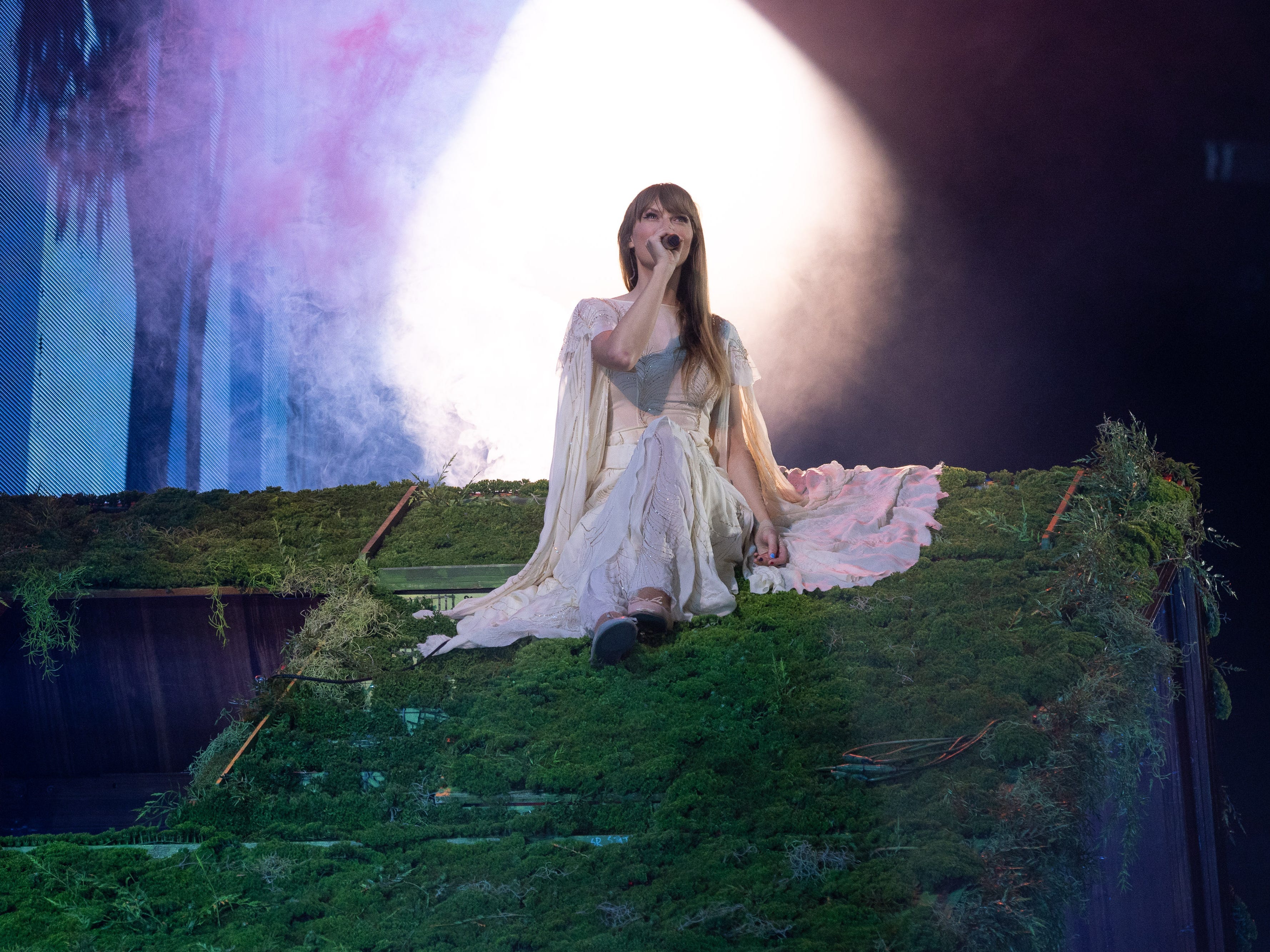
Terence Rushin/TAS23/Getty Images for TAS Rights Management
Many fans have noticed a parallel between “Invisible String” and Charlotte Brontë’s Victorian-era novel “Jane Eyre,” when Mr. Rochester finally professes his love for the titular heroine.
“I sometimes have a queer feeling with regard to you — especially when you are near me, as now: it is as if I had a string somewhere under my left ribs, tightly and inextricably knotted to a similar string situated in the corresponding quarter of your little frame,” Rochester says.
However, the chorus of “Invisible String” also resembles the closing dialogue in “The Sun Also Rises,” Ernest Hemingway’s wartime novel that draws a tragic line between wanting and having.
Throughout the story, the narrator Jake pines for his friend Brett, even though both characters understand they can’t meet each other’s needs.
In the last scene, Brett wistfully tells Jake, “We could have had such a damned good time together.”
Jake replies: “Isn’t it pretty to think so?”
Because Jake loves Brett but they can never be together, Jake means it’s “pretty” because it’s merely a fantasy. Brett’s comment doesn’t reflect the harsh reality of their situation.
Similarly, Swift sings, “Isn’t it just so pretty to think / All along there was some / Invisible string tying you to me?”
She seems to suggest it’s “pretty” to think fate brought her true love because the reality is less attractive — or perhaps that she’s been “scheming like a criminal” to get what she wants, as she admits in “Mastermind.”
Swift’s word choice could also suggest that she sensed the relationship was doomed from the start, even if it looked good from the outside.
This ambivalent interpretation is echoed in Swift’s prologue to “Folklore,” in which she describes the song’s imagery as “a single thread that, for better or worse, ties you to your fate.”
“Mad Woman” thematically resembles “Wide Sargasso Sea” by Jean Rhys, a prequel to “Jane Eyre.”
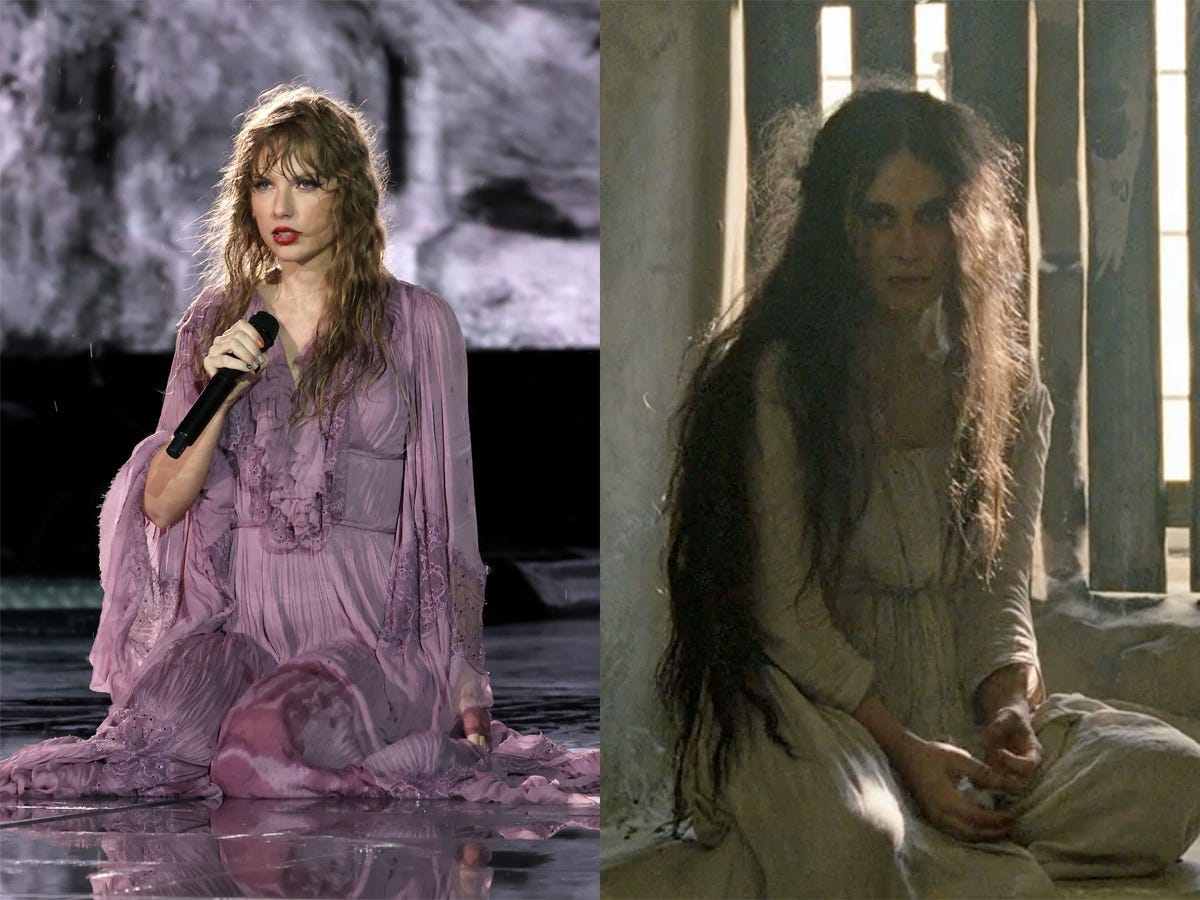
John Shearer/TAS23/Getty Images for TAS Rights Management; Focus Features
The premise of “Mad Woman” can be easily connected to the oft-cited proverb from “The Mourning Bride” by William Congreve: “Hell hath no fury like a woman scorned.”
However, Swift’s use of the word “mad,” an adjective that can mean both angry and crazy, feels very intentional. Once again, it calls to mind “Jane Eyre.”
When Jane finally agrees to marry Mr. Rochester in Brontë’s novel, it’s revealed that he already has a wife named Bertha Antoinette Mason, who’s been locked away in his attic.
“Bertha Mason is mad; and she came of a mad family — idiot and maniacs through three generations! Her mother, the Creole, was both a mad woman and a drunkard!” Rochester tells Jane. “Bertha, like a dutiful child, copied her parent in both points.”
Rochester claims he imprisoned Bertha because she lost her mind, painting it as a genetic illness — passed down from her mother, specifically.
Jean Rhys gives Bertha a more sympathetic backstory in her 1966 novel “Wide Sargasso Sea.” The prequel reimagines how Antoinette Cosway, a Creole heiress, became “Bertha” in her unhappy marriage to Rochester. In short, she was driven to madness by his patriarchal cruelty.
At one point in the novel, Antoinette scolds her new husband for believing lies about her family.
“I know what he told you. That my mother was mad and an infamous woman and that my little brother who died was born a cretin, an idiot, and that I am a mad girl too,” she says.
She adds: “There is always another side, always.”
Antoinette’s old nurse Christophine also denounces these rumors, accusing Rochester of greed and betrayal: “You want her money but you don’t want her. It is in your mind to pretend she is mad.”
The themes of “Wide Sargasso Sea” are reflected in “Mad Woman,” which fans believe was inspired by the sale of Swift’s music recordings without her consent.
“Every time you call me crazy, I get more crazy, what about that? And when you say I seem angry, I get more angry,” she sings. “And there’s nothing like a mad woman / What a shame she went mad / No one likes a mad woman / You made her like that.”
“The Lakes” pays tribute to William Wordsworth and the Romantic poets of the 18th century.
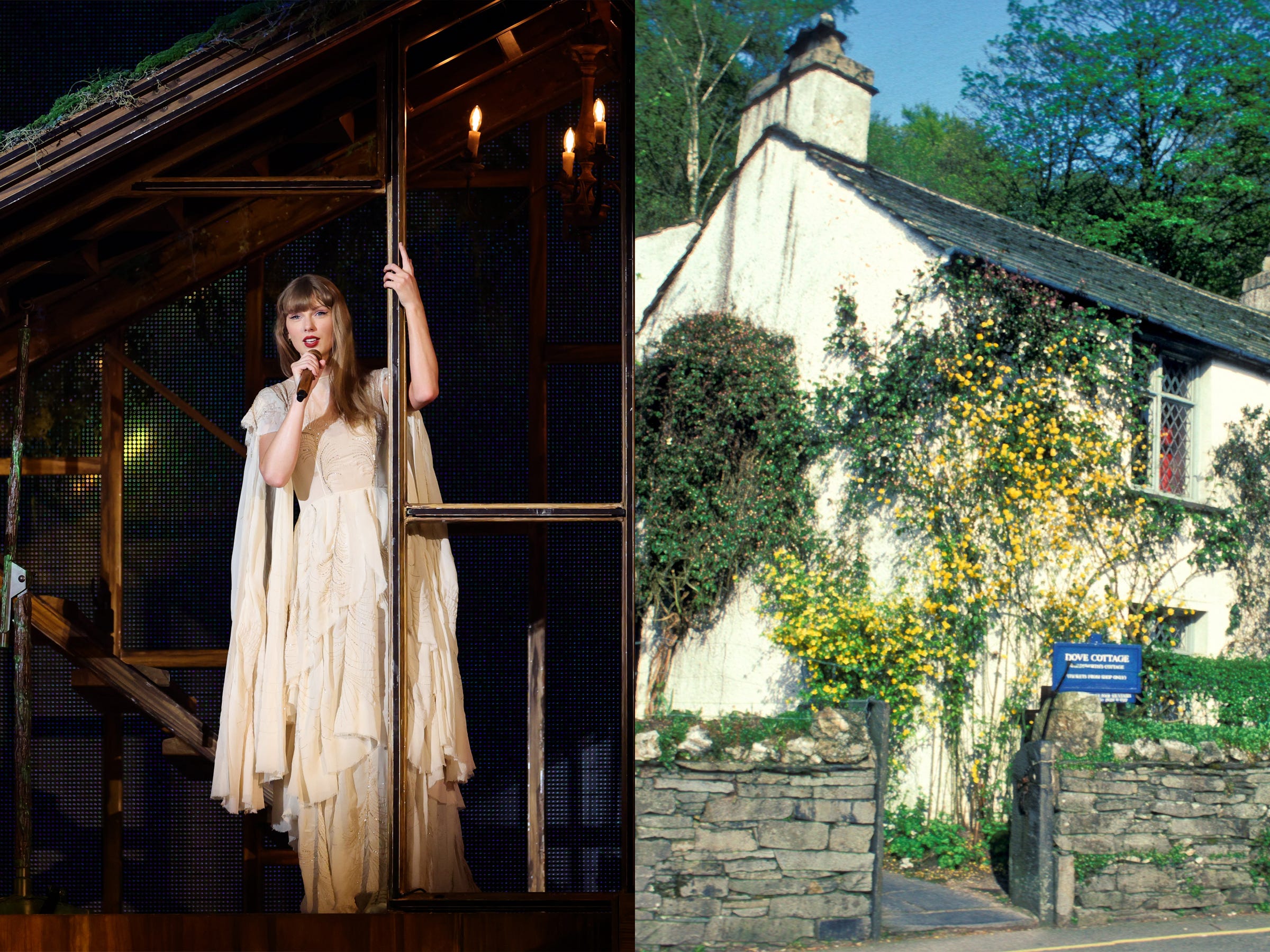
Andreas Rentz/TAS24/Education Images/Universal Images Group via Getty Images
Swift references poetry throughout “The Lakes,” specifically Romanticism, which was an 18th-century movement that valued emotional expression over logic and reason.
Romantic poets were empathetic rather than judgmental; instinctive rather than self-conscious. They believed in embracing “the bliss of solitude,” writing as a way of understanding one’s own mind, and cultivating the correlation between joy and imagination.
Indeed, one could argue that “Folklore” is a modern revival of Romanticism, and Swift herself seems to make that argument in “The Lakes.”
“Is it romantic how all my elegies eulogize me?” Swift sings to open the song.
In the second verse, she adds: “I’ve come too far to watch some namedropping sleaze / Tell me what are my words worth.”
In addition to praising the value of her own work, Swift draws a semantic connection to William Wordsworth, one of the founders of the Romantic movement.
In the preface to his collection “Lyrical Ballads,” Wordsworth wrote, “Poetry is the spontaneous overflow of powerful feelings: it takes its origin from emotion recollected in tranquility.”
At age 29, Wordsworth relocated to the village of Grasmere in the county of Cumbria, located in the heart of England’s Lake District. He was inspired by the natural landscape and wrote many of his best-known poems in the following years at Dove Cottage, which has now been enshrined as a museum.
During this time, Wordsworth’s brother died in a shipwreck. The loss inspired him to write three elegies: “I only look’d for pain and grief,” “Distressful gift! this Book receives,” and “To the Daisy.”
According to Professor Sir Jonathan Bate, an expert in English literature and Romanticism, Wordsworth was “the first poet to write elegies that eulogized himself.”
In the bridge of “The Lakes,” Swift begs for “auroras and sad prose” while she frets and cries amid the lakes and Windermere peaks.
Wordsworth made a similar reference in a 1791 letter: “Such an excursion would have served like an Aurora Borealis to gild your long Lapland night of melancholy.”
He also uses the imagery of a “Lapland night” in a poem titled “To a Young Lady, Who had been Reproached for Taking Long Walks in the Country.”
Wordsworth addresses a woman who can feel herself growing older, who is inspired by isolation to reflect on the “heart-stirring days” in her life.
Wordsworth’s muse closely resembles Swift during the “Folklore” era. The pensive album, born during quarantine, was the first she released after turning 30.
Swift had previously expressed her fear of aging as a female entertainer, describing the industry as an “elephant graveyard” full of older women: “As I’m reaching 30, I want to work really hard while society is still tolerating me being successful,” she said in her Netflix documentary “Miss Americana.”
However, Wordsworth’s poem offers an alternative vision of aging as “serene and bright,” painting his muse as “a light to young and old.” (Additionally, Wordsworth himself penned most of his best poems after turning 30).
“Thy thoughts and feelings shall not die, / Nor leave thee, when grey hairs are nigh,” he writes.
“Tolerate It” was partially inspired by “Rebecca.”

Terence Rushin/TAS23/Getty Images for TAS Rights Management
“Rebecca,” Daphne du Maurier’s 1938 Gothic novel, follows a shy young woman who is never given a first name.
After a brief courtship, she marries a wealthy widower named Maxim de Winter. Early on, she describes herself as “a little scrubby schoolboy” and her new husband as “kinder, and far more inaccessible.”
The relationship Swift describes in “Tolerate It” mirrors this dynamic: “You’re so much older and wiser and I / Wait by the door like I’m just a kid.”
Maxim remains haunted by the death of his first wife, Rebecca, which makes him distant and unaffectionate toward the narrator.
“I was thinking, ‘Wow, her husband just tolerates her. She’s doing all these things and she’s trying so hard and she’s trying to impress him, and he’s just tolerating her the whole time,'” Swift told Apple Music’s Zane Lowe. “There was a part of me that was relating to that, because at some point in my life, I felt that way.”
The final line of “Tolerate It” is submissive and ambiguous (“I sit and watch you”), leaving the listener to wonder if Swift’s heroine will ever have the strength to speak up for herself.
However, “Rebecca” is recounted as a flashback, so the reader knows the narrator has survived her painful ordeal.
“Happiness” also seems to reference Gatsby, Daisy, and the green light.

Taylor Hill/TAS23/Getty Images; Warner Bros
“Happiness” tells the story of a longtime relationship that turned sour. Swift said it’s about “the realization that maybe the only path to healing is to wish happiness on the one who took it away from you.”
The song is sprinkled with symbols of longing and regret that appear in “The Great Gatsby.”
“Tell me, when did your winning smile / Begin to look like a smirk?” she sings in verse two.
Alone, this would not seem like a literary reference. But in context, this is reminiscent of how Nick, the book’s narrator, describes his early impression of Gatsby.
“He had one of those rare smiles with a quality of eternal reassurance in it, that you may come across four or five times in life,” Nick explains. “It faced, or seemed to face, the whole external world for an instant and then concentrated on you with an irresistible prejudice in your favor.”
This smile is the essence of Gatsby’s charm. But his “irresistible prejudice in your favor” could be interpreted as manipulative, or at least performative.
Also in verse two, Swift sings pointedly, “I hope she’ll be a beautiful fool / Who takes my spot next to you.”
The term “beautiful fool” is taken from Gatsby’s muse, Daisy, who is in a loveless marriage with an unfaithful man.
“I hope she’ll be a fool,” Daisy says of their young daughter. “That’s the best thing a girl can be in this world, a beautiful little fool.”
Swift has said that “Evermore” contains an “‘unhappily ever after’ anthology of marriages gone bad,” so her reference to Daisy’s quote is very telling. It points to a distinctly feminine anger, a sense of helplessness — and ties “Happiness” to her songs about infidelity, like “No Body, No Crime” and “Illicit Affairs.”
Finally, Swift makes Gatsby’s influence clear by using the book’s most recognizable symbol.
“After giving you the best I had / Tell me what to give after that / All you want from me now is the green light of forgiveness,” she sings in the third verse.
In “The Great Gatsby,” the green light at the end of Daisy’s dock represents Gatsby’s undying love (or obsession, depending on how you look at it). Nick refers to the light as an “enchanted object,” because its only significance is what Gatsby pours into it.
Perhaps Swift is suggesting that the concept of “forgiveness” isn’t as powerful as it seems, especially if you believe that it could magically absolve many years of pain.
“You know, people go on and on about, like, you have to forgive and forget to move past something. No, you don’t,” Swift said in 2019. “You don’t have to forgive and you don’t have to forget to move on.”
Many fans believe “Ivy” was inspired by Emily Dickinson and Sue Gilbert.
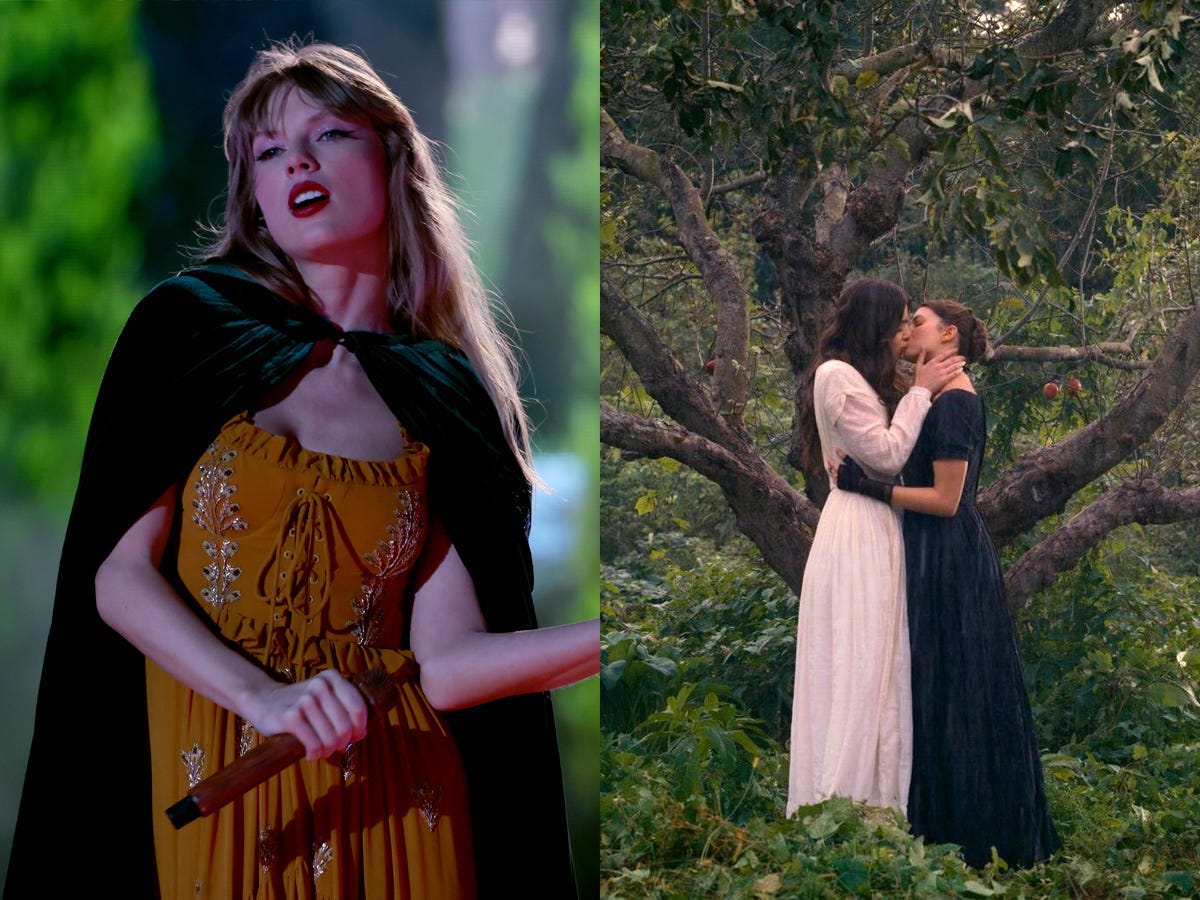
John Shearer/TAS23/Getty Images; Apple TV+
“Ivy,” the 10th track on “Evermore,” is written from the perspective of a married woman who is falling in love with someone else (“So tell me to run / Or dare to sit and watch what we’ll become / And drink my husband’s wine”).
Swift’s narrator says she’s “grieving for the living,” which could mean she’s incapable of being with the person she loves in public. She serenades her illicit lover throughout the song (“My pain fits in the palm of your freezing hand”), but never provides a name or a gendered pronoun. So “Ivy” could tell the story of a sapphic affair.
Indeed, many fans have theorized that “Ivy” was inspired by Emily Dickinson. Scholars believe the poet was a lesbian and in love with her childhood best friend, Sue Gilbert, who ended up marrying Dickinson’s brother.
The Apple TV+ series “Dickinson” celebrates the poet’s queerness and focuses largely on her clandestine romance with Gilbert. At the end of a 2021 episode titled “Grief Is a Mouse,” the women reunite for a passionate sex scene that leads into the credits, soundtracked by “Ivy.”
Swift herself approved the song’s usage in the show, according to showrunner Alena Smith.
“I really wanted to use that song. I mean, I love that song, and also the fans have sort of developed a mythology around it as being a song that relates to Emily and Sue on some emotional level,” Smith told The Hollywood Reporter, adding, “We were lucky that Taylor said yes.”
“Evermore” contains possible references to Dickinson and Brontë.
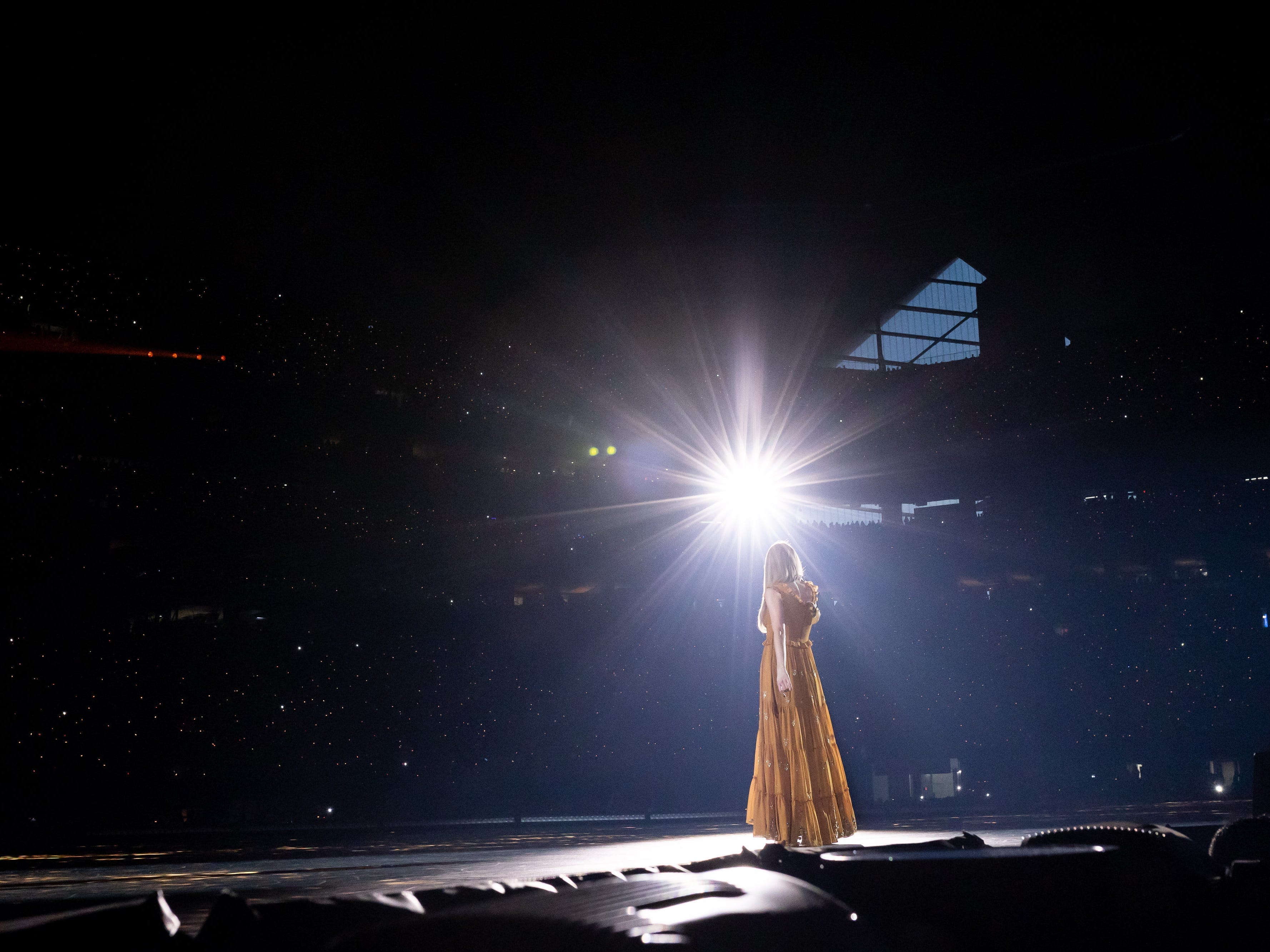
Terence Rushin/TAS23/Getty Images for TAS Rights Management
“Evermore” is, of course, the titular track of Swift’s album “Evermore,” which was announced on Dickinson’s birthday (December 10).
One of Dickinson’s most widely read poems, known as “One Sister have I in our house,” ends with the line, “Sue – forevermore!”
The poem shows Dickinson grappling with the loss of innocence, which is made more bearable by the love and support of her muse: “Today is far from Childhood / But up and down the hills / I held her hand the tighter / Which shortened all the miles.”
Swift echoes this theme in “Evermore,” in which she describes feeling lost and “unmoored.” As in Dickinson’s poem, her pain is eased by her muse: “And when I was shipwrecked / I thought of you / In the cracks of light / I dreamed of you / It was real enough / To get me through.”
Additionally, as Bate noted in a piece for The Times UK, lyrics like “the cracks of light” and “floors of a cabin creaking under my step” seem to evoke Dickinson’s work and “the claustrophobia of the 19th-century New England genius.”
“Evermore” also contains another “Jane Eyre” parallel in the first verse: “Writing letters addressed to the fire.”
After Rochester’s marriage to Bertha is revealed, Jane flees. She sends letters back to his estate, only to return months later and discover it has burned down.
In “Evermore,” this image seems to represent misunderstanding and regret, all the words Swift left unsaid — but for Jane, the fire is a cleansing force. In killing Bertha, the fire allows Jane to marry Rochester and gives her a second chance at love.
The title of “Dear Reader” evokes the most iconic line from “Jane Eyre.”
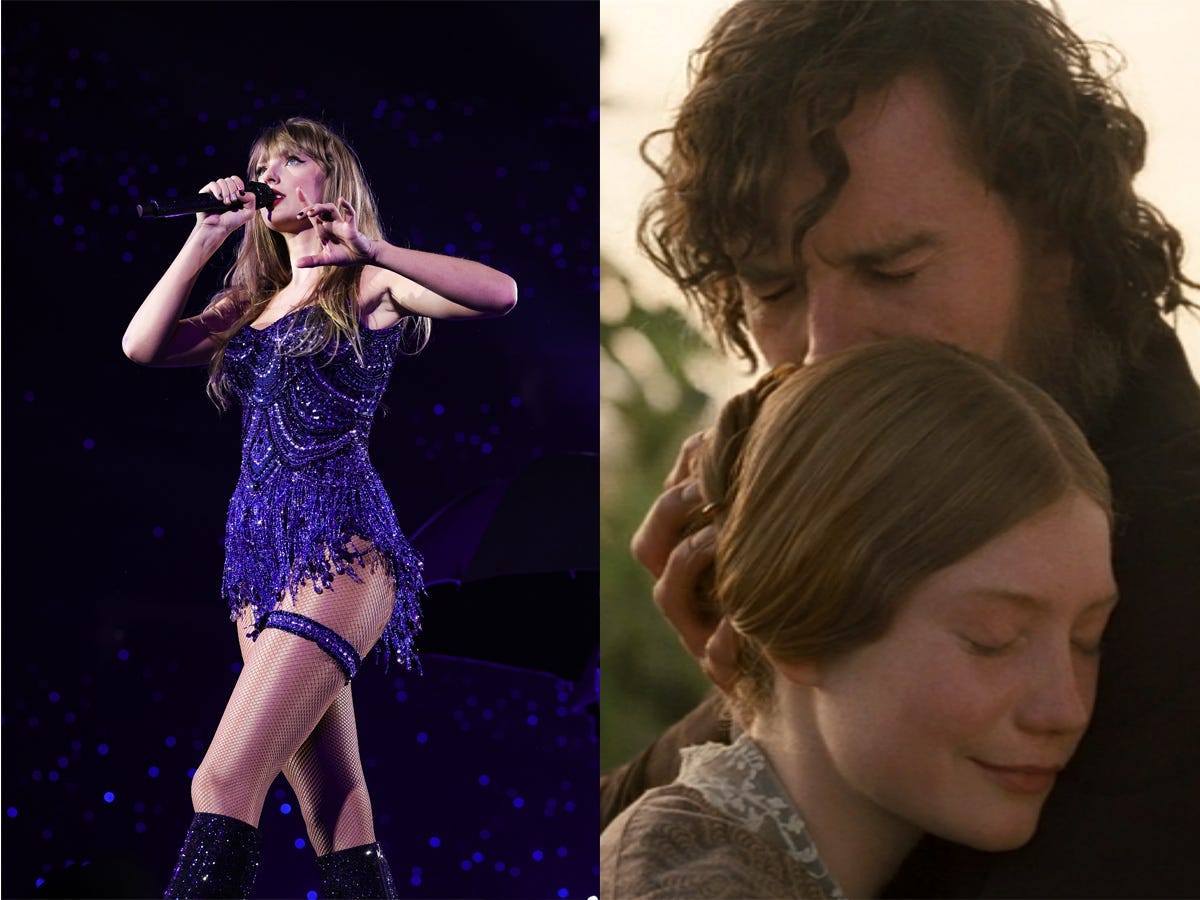
Ethan Miller/TAS23/Getty Images for TAS Rights Management; Focus Features
The title “Dear Reader” is another likely reference to “Jane Eyre,” which features one of the most beloved lines in English literature: “Reader, I married him.”
Like Brontë’s protagonist, Swift breaks the fourth wall and addresses her audience directly throughout the song.
However, Swift flips the script with “Dear Reader,” the final track on “Midnights (3am Edition).”
Even though many readers consider Jane Eyre a feminist figure, especially by 19th-century standards, she still follows the typical path of women in literature. Much like her contemporaries Elizabeth Bennett and Jo March, all known as independent and headstrong characters, Jane’s story still culminates in marriage.
Even today, female leads are expected to land a man by the end of the story.
However, at the end of “Midnights,” Swift stands alone. Instead of treating a man as the prize, she keeps the spotlight trained on her own accomplishments, regrets, and lessons learned along the way.
While it’s not exactly a triumphant conclusion (“No one sees when you lose when you’re playing solitaire”), Swift creates a fascinating tension by evoking Brontë’s famous line, only to undermine its implications.
“Who’s Afraid of Little Old Me?” references Virginia Woolf and possibly Plath again.
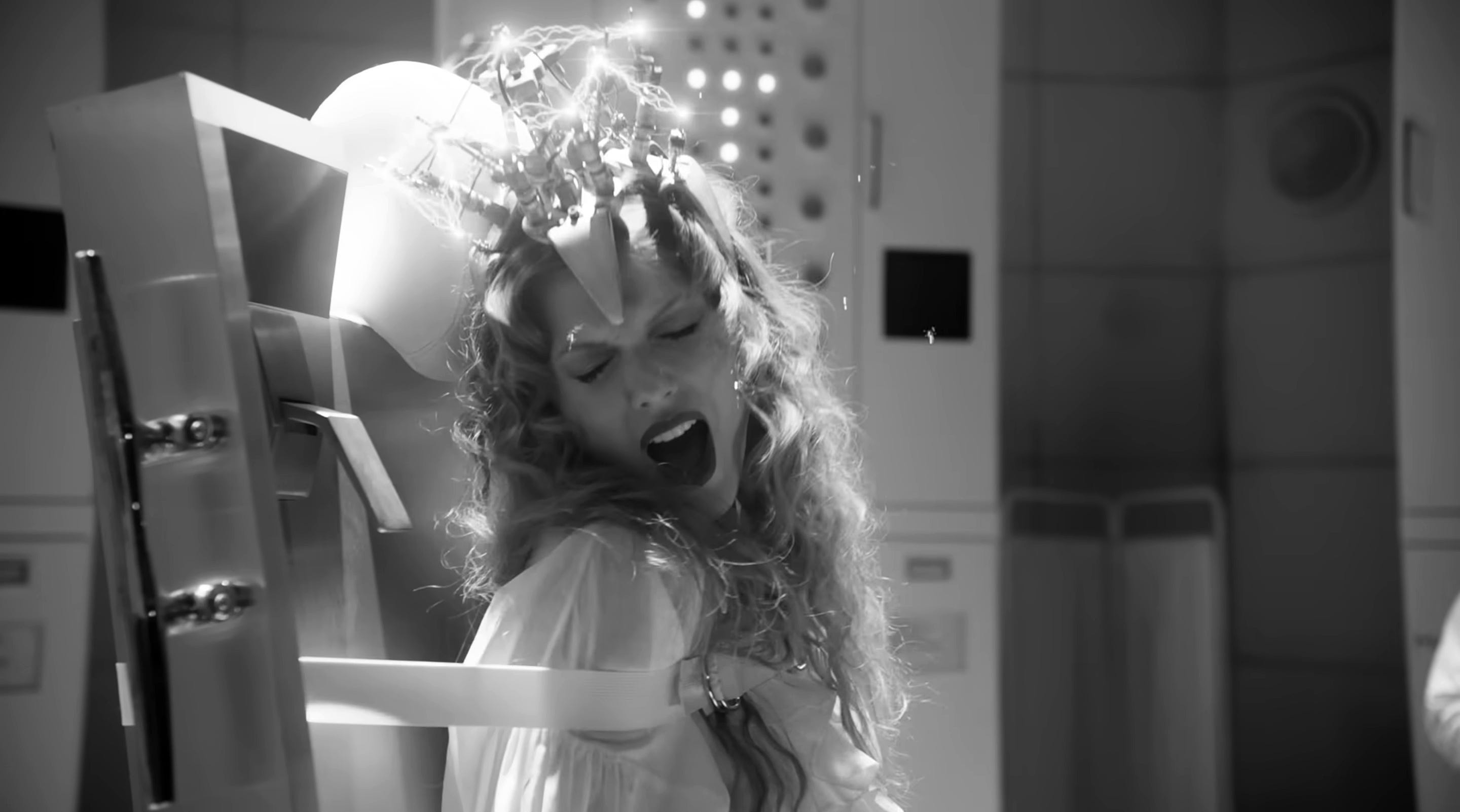
Taylor Swift/YouTube
The title of “Who’s Afraid of Little Old Me?” is almost certainly a reference to “Who’s Afraid of Virginia Woolf?” — a 1962 play written by Edward Albee — which is itself a reference to the 1933 Disney song “Who’s Afraid of the Big Bad Wolf?”
Woolf is best known for using a stream-of-consciousness literary technique in her poetry and prose. Meanwhile, Ablee’s play is a dark comedy about a dysfunctional couple, full of delusions and emotional outbursts — much like Swift’s “The Tortured Poets Department,” an album that chronicles, in Swift’s own words, “a mutual manic phase” mistaken for a love affair.
Beyond its title, “Who’s Afraid of Little Old Me?” also revisits the Lady Lazarus-esque circus imagery from “Mirrorball.”
“I was tame, I was gentle ’til the circus life made me mean / ‘Don’t you worry, folks, we took out all her teeth,'” Swift sings in the chorus. Later, she leers, “You wouldn’t last an hour in the asylum where they raised me.”
While Swift uses the asylum as a metaphor for growing up under constant surveillance, Plath was literally hospitalized after a suicide attempt in college. Her semi-autobiographical novel “The Bell Jar” tells a version of her experience. The book’s protagonist, Esther Greenwood, is treated with electroshock therapy.
In the music video for “Fortnight,” the lead single from “The Tortured Poets Department,” Swift’s hospitalized character also receives electroshock therapy.
“The Albatross” makes use of symbolism from Samuel Coleridge’s poetry.
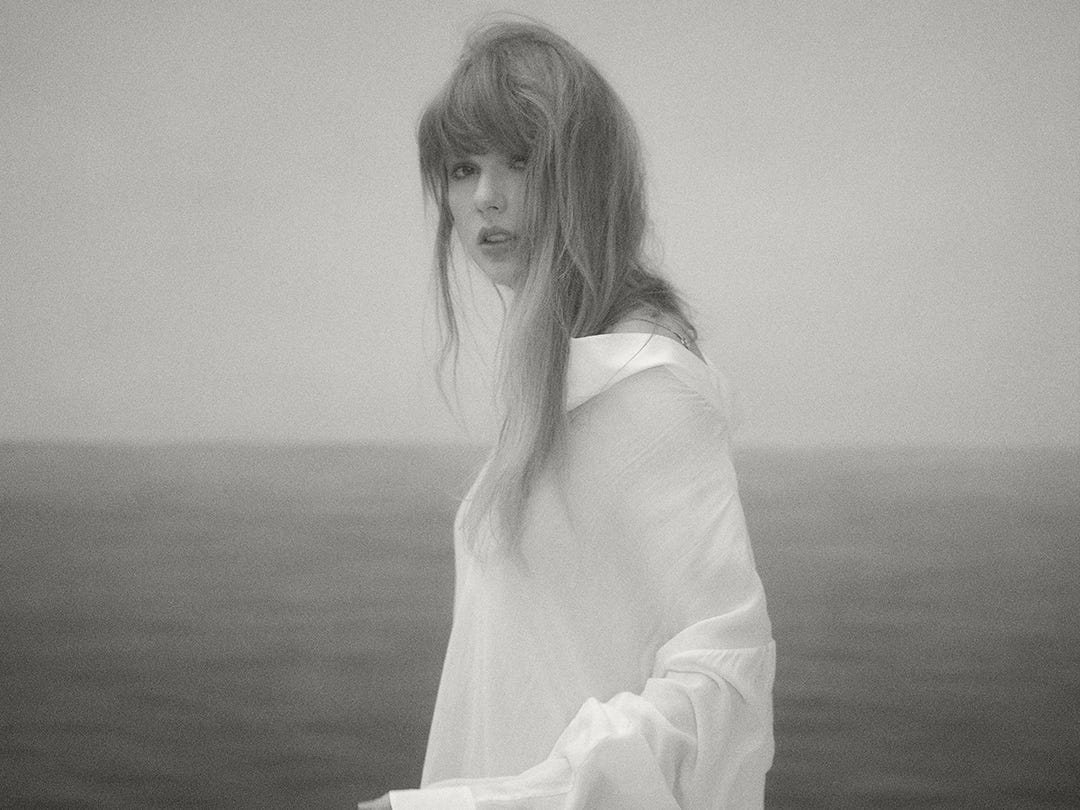
Beth Garrabrant
The albatross is a crucial element in Samuel Coleridge’s 1834 poem “The Rime of the Ancient Mariner,” considered a pillar of Romanticism.
The poem centers on a “bright-eyed Mariner,” who singles out one man, a wedding guest, to whom he tells his life story. The Mariner tells the wedding guest that once on his ship, he inexplicably shot and killed an albatross, a type of large seabird.
The Mariner then recounts the fantastical, nightmarish consequences that followed. He says that spirits played dice to win the lives of the men on board, the ship’s crew was transformed into animated skeletons, and his own life was spared, but his soul was sacrificed: “Instead of the cross, the Albatross / About my neck was hung.”
He never explains why he killed the albatross, and Coleridge offers no overarching moral. The bird has come to symbolize guilt, burden, and the ripple effects of rash, thoughtless action.
In Swift’s “The Albatross,” she leans on the bird’s symbolism as a harbinger of danger and destruction.
By the end of the song, it’s clear that Swift is comparing herself to the albatross. Her arrival in someone’s life is treated as a bad omen — namely by those who don’t know her personally, only by reputation. These people, sarcastically called “wise men,” offer cautious platitudes to her prospective friends and lovers, like “Wild winds are death to the candle” and “One bad seed kills the garden.” In the third verse, Swift makes it clear they’re not as well-informed as they appear: “Wise men once read fake news, and they believed it.”
In the final chorus, Swift reclaims the bird as a symbol of redemption and survival: “So I crossed my thoughtless heart / Spread my wings like a parachute / I’m the albatross / I swept in at the rescue.”
“The Fate of Ophelia” subverts a tragic death in Shakespeare’s “Hamlet.”
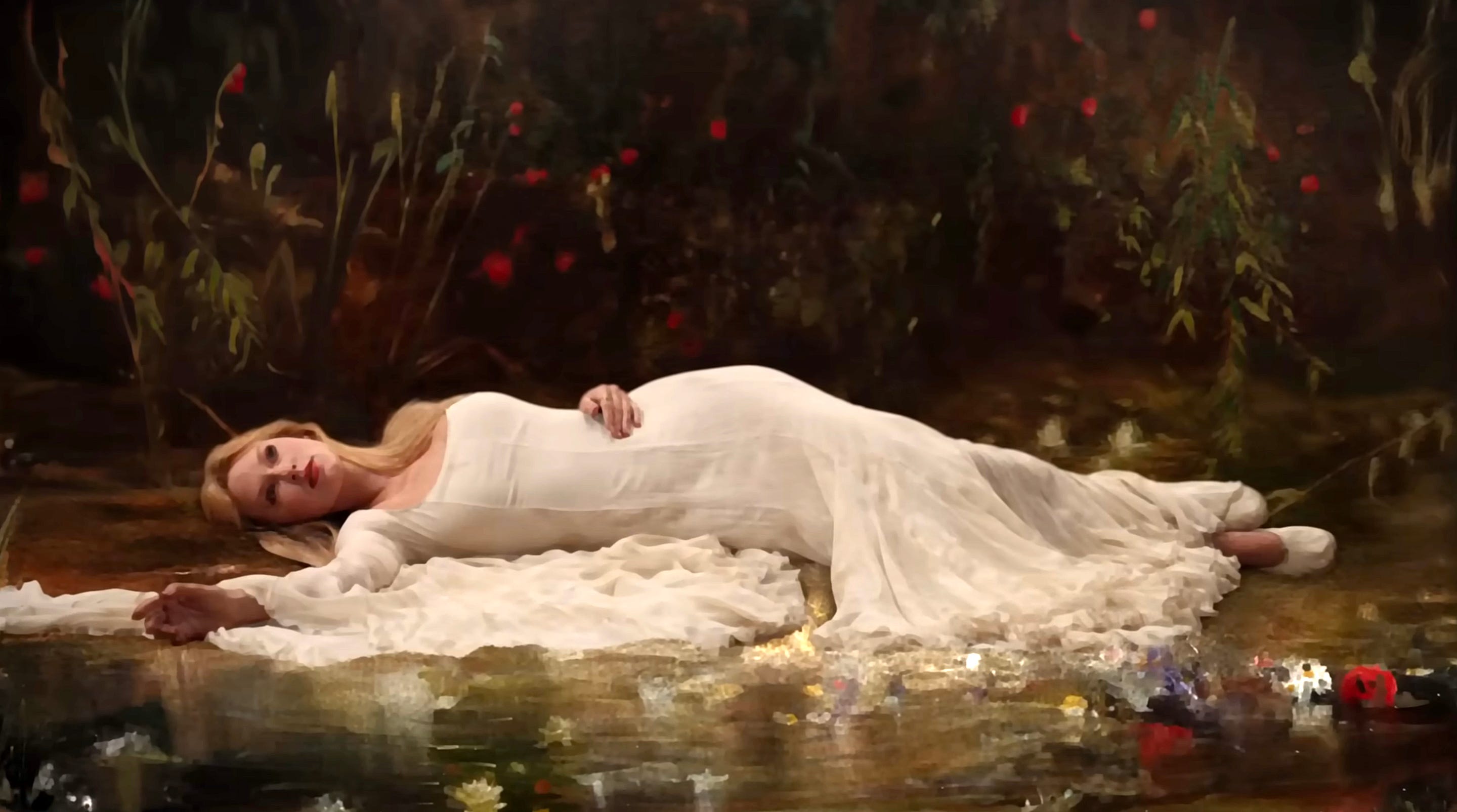
Taylor Swift/YouTube
Swift’s newest single, “The Fate of Ophelia,” follows in the footsteps of “Love Story” by explicitly naming a Shakespearean character and boldly rewriting her fate.
In Shakespeare’s “Hamlet,” Ophelia’s identity is defined by her relationship to the play’s male characters: She is the daughter of Polonius, the sister of Laertes, and the love interest of the titular protagonist.
As Hamlet grapples with his father’s death and mother’s betrayal, turning ever-inward, he also turns on Ophelia, shaming her for her sexuality, her beauty, and her perceived naivety. In Act 3, he murders her father.
Although Hamlet didn’t know it was Polonius he was stabbing, this rare moment of decisiveness sets Ophelia on her own downward spiral. She loses her grip on reality and ends up drowning offstage, either by accident (as Queen Gertrude claims) or by madness-induced suicide (as most people assume).
In Swift’s theatrical event, “The Official Release Party of a Showgirl,” she explained how she used Ophelia’s plight as inspiration.
“Ophelia drowned because Hamlet just messed with her head so much that she went crazy, and she couldn’t take it anymore, and all these men were just gaslighting her until she drowned,” Swift said. “What if the hook is that you saved my heart from the fate of Ophelia? Basically, like, you are the reason why I didn’t end up like this tragic, poetic heroine.”
Swift’s plot twist mirrors her shift from the heartbroken “Tortured Poets” era to the upbeat “Showgirl” era, which includes her engagement to Travis Kelce. “The Fate of Ophelia” describes how Swift felt resigned to a life of loneliness and melancholy until she found a partner who made her feel cherished and alive.
In the bridge, Swift drives home the reference with paraphrased versions of Ophelia’s quotes.
“‘Tis locked inside my memory / And only you possess the key,” Swift sings, recalling Ophelia’s promise to her brother in Act 1, Scene 3 (“‘Tis in my memory locked, / And you yourself shall keep the key of it”).
Swift’s next couplet, “No longer drowning and deceived / All because you came for me,” is an obvious reference to Ophelia’s death, but it also echoes an exchange between Ophelia and Hamlet in Act 3, Scene 1.
“I did love you once,” Hamlet tells Ophelia. She replies, “Indeed, my lord, you made me believe so.”
Immediately, Hamlet flips, telling her, “You should not have believed me… I loved you not.” Ophelia replies, “I was the more deceived.”
Read the original article on Business Insider
The post 25 Taylor Swift songs with literary references you may have missed, from ‘All Too Well’ to ‘The Fate of Ophelia’ appeared first on Business Insider.
